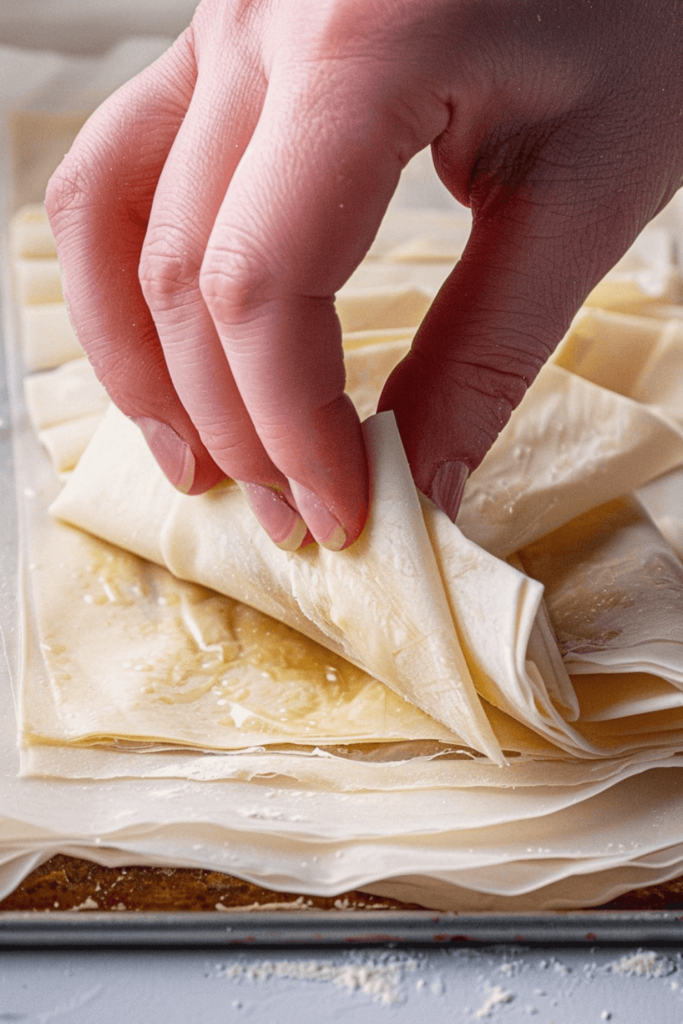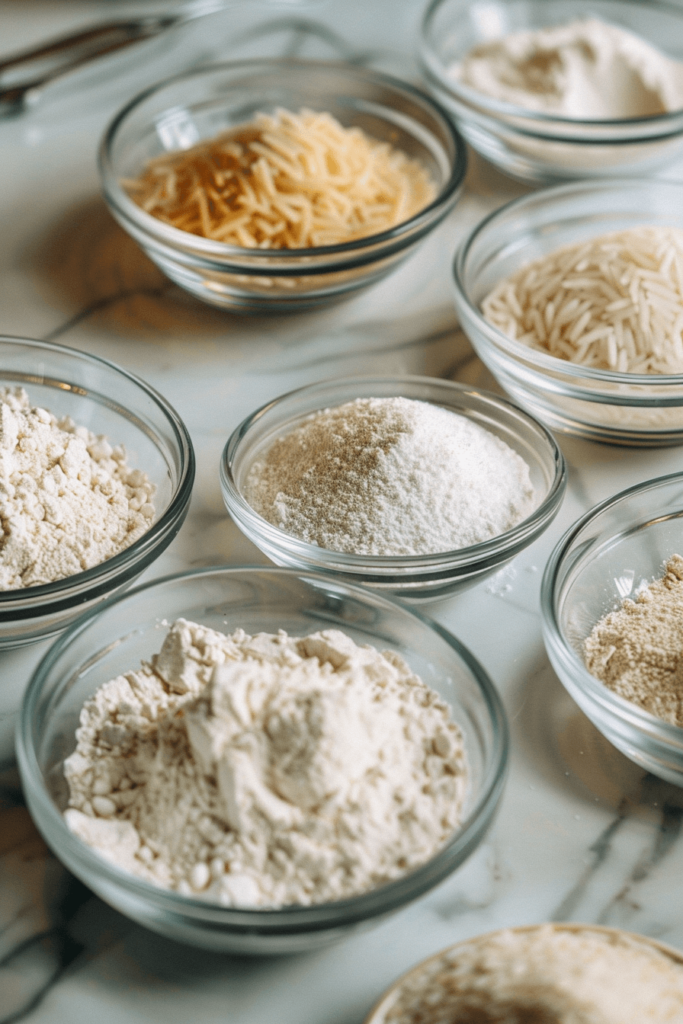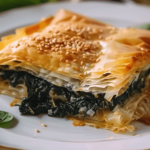If you’ve ever tried making traditional filo pastry at home, you know it takes more patience than assembling IKEA furniture without the manual. Now imagine doing it without gluten. Sounds like sorcery? Maybe. But gluten free filo sheets are very real, incredibly flaky, and- believe it or not – totally doable at home.

In this article, we’ll walk through everything you need to know about making, buying, and using gluten free filo sheets. From ingredient swaps to baking tips, nutrition comparisons, and clever substitutes, it’s all here. Whether you’re celiac, gluten-sensitive, or just health-curious, this guide will give you the full filo experience—without the wheat.
Looking for inspiration? Try our 3-day detox weight loss smoothie to complement your healthy pastry lifestyle. Now, let’s start with what gluten free filo really is and why it’s worth the hype.
Table of Contents
Understanding Gluten Free Filo Sheets
What Are Gluten Free Filo Sheets and Why Are They Different?
Gluten free filo sheets are thin, paper-like layers of pastry made without wheat flour. Instead, they’re typically crafted from a combination of gluten-free flours like rice flour, tapioca starch, sorghum, or even potato starch. What makes them so impressive is their ability to replicate the crisp, flaky texture of traditional filo—even without the gluten to hold everything together.
While traditional filo relies on the elasticity of gluten to stretch into whisper-thin sheets, the gluten free version leans on binding agents like xanthan gum, psyllium husk, or even gelatin substitutes to mimic that stretchy behavior.
The result? Light, shatteringly crisp layers that puff up and brown beautifully—ideal for everything from spinach pies and baklava to savory turnovers and dessert cups.
Brief History of Filo Pastry and Gluten-Free Innovations
Filo, also spelled phyllo, has been a staple of Middle Eastern and Mediterranean cuisine for centuries. The word “filo” comes from the Greek word for “leaf,” which is fitting, since traditional filo dough is almost as thin as one.
As awareness around gluten intolerance and celiac disease grew, so did the demand for gluten free alternatives to beloved classics. Initially, gluten free filo was a culinary pipe dream—too delicate, too elastic, too fussy. But through innovation and flour science (yes, that’s a thing), gluten free filo sheets have become a real contender.
Why Go Gluten-Free? Health and Dietary Motivations
For people with celiac disease, consuming even a trace of gluten can trigger severe intestinal damage. For others, gluten may cause bloating, fatigue, or digestive discomfort. And some simply avoid it as part of a wellness-focused lifestyle.
Choosing gluten free filo sheets is a smart move for:
- Individuals with celiac or gluten sensitivity
- Health-conscious bakers seeking lighter pastries
- Dieters reducing refined wheat products
- Vegans and vegetarians (many GF filo recipes are egg-free)
Whether you’re following a strict diet or simply curious about new ingredients, gluten free filo can help you enjoy your favorite flaky treats—minus the discomfort.
Ingredients Breakdown & Gluten-Free Alternatives
Key Ingredients in Traditional vs. Gluten Free Filo Sheets

To understand what makes gluten free filo sheets work, it’s important to first peek at the ingredient list of traditional filo. Classic filo dough typically includes:
- All-purpose flour (wheat-based)
- Water
- A splash of vinegar or lemon juice
- Oil (like olive oil or sunflower oil)
- Sometimes salt
That’s it—no eggs, no butter, and certainly no sugar. But what it lacks in ingredients, it makes up for in technique: those sheets are stretched thin enough to see through. When creating a gluten-free version, though, the game changes dramatically.
Gluten free filo sheets ditch the wheat and often include:
- Rice flour: A mild, lightweight flour that forms the foundation of most gluten-free baking recipes.
- Tapioca starch: For chew and stretchiness.
- Sorghum or millet flour: These hearty flours help build structure and offer a texture similar to traditional wheat flour.
- Psyllium husk or xanthan gum: Essential binding agents to simulate gluten’s elasticity.
- Cornstarch or potato starch: Helps create the crisp finish.
These ingredients work together to provide the delicate balance of pliability and crunch, allowing you to roll and layer sheets without major frustration—or breakage.
Best Gluten Free Flours for Making Filo Pastry
Not all gluten free flours are created equal. Some are gritty, others too soft. If you want gluten free filo sheets that don’t fall apart like a bad Zoom connection, use the right flour combo. Here are your best bets:
| Flour Type | Why It Works |
|---|---|
| Rice Flour | Fine texture, neutral taste, forms the base. |
| Tapioca Starch | Adds elasticity and chew, mimicking gluten. |
| Potato Starch | Boosts crispness and lightness. |
| Millet Flour | Slightly nutty flavor, enhances structure. |
| Sorghum Flour | Close texture to wheat flour, supports elasticity. |
You’ll often need a blend—typically a 2:1:1 ratio of rice flour to starches (like tapioca and potato starch). Too much of one component can make the dough too sticky, dry, or brittle. It’s like baking with Goldilocks—everything has to be just right.
Substitutes for Elasticity and Stretch in GF Filo
The number one challenge in making gluten free filo is replicating gluten’s elasticity. That stretchiness is what lets filo dough become thinner than your smartphone screen without cracking. Since we’re leaving gluten at the door, we need clever substitutes.
Top Gluten-Free Stretch Agents:
- Xanthan Gum: A little goes a long way. It’s the MVP of GF elasticity.
- Psyllium Husk Powder: Adds flexibility and helps trap moisture.
- Gelatin (vegan or regular): Some recipes use it to boost stretch for paper-thin rolling.
- Egg Whites (optional): Can add pliability in non-vegan versions.
Keep in mind, it’s not just about adding these stretchers—you’ve got to knead and rest the dough appropriately to activate their properties. And yes, there’s a resting period involved (sorry, no shortcuts here). But give the dough time to relax, and it’ll roll smoother, thinner, and with fewer cracks.
Print
Gluten Free Filo Sheets
- Total Time: 1 hour 10 mins
Ingredients
1 cup white rice flour
½ cup tapioca starch
½ cup potato starch
1 tsp xanthan gum
½ tsp salt
2 tbsp olive oil
¾ cup warm water
Instructions
Mix dry ingredients.
Add oil and water to form soft dough.
Knead and rest 30–45 min.
Roll thin sheets, layer with oil, and use as needed.
- Prep Time: 45 mins
- Cook Time: 25 mins
How to Make Gluten Free Filo Sheets at Home
Making gluten free filo sheets at home might sound like a job for a pastry chef with magical powers—but it’s actually easier than you think. With a good recipe, a few pantry staples, and a bit of patience, you can create these thin, flaky layers right in your kitchen. And the best part? You get full control over what goes into your gluten free filo sheets—no preservatives, no gluten, just pure crispy goodness.
Step-by-Step Recipe for Homemade Gluten Free Filo Sheets
Ready to roll? Here’s how you can make your very own gluten free filo sheets at home—thin, flexible, and perfectly crisp once baked.
Ingredients:
| Ingredient | Amount |
|---|---|
| White rice flour | 1 cup (120g) |
| Tapioca starch | ½ cup (60g) |
| Potato starch | ½ cup (60g) |
| Xanthan gum | 1 tsp |
| Salt | ½ tsp |
| Olive oil | 2 tbsp |
| Warm water | ¾ cup (180ml) |
Optional: 1 tsp apple cider vinegar for added elasticity
Instructions:
- Mix Dry Ingredients: In a large mixing bowl, combine rice flour, tapioca starch, potato starch, xanthan gum, and salt. This is the dry base for your gluten free filo sheets.
- Combine the wet ingredients: Slowly add the olive oil and warm water to the dry mix. The dough should feel soft and slightly sticky, yet firm enough to roll out smoothly.
- Gentle kneading: Work the dough on a clean, flat surface for a few minutes until it feels smooth and well-blended.
- Allow the dough to rest: Cover it with a damp cloth or plastic wrap and let it sit at room temperature for 30 to 45 minutes. This helps the ingredients hydrate and bind properly.. This step helps activate the binding agents—essential for soft, rollable gluten free filo sheets.
- Divide and Roll: Cut dough into small balls. Dust a clean surface with starch and roll each ball as thin as you can—ideally, until the dough becomes almost translucent. Don’t worry if a few sheets tear; gluten free filo sheets are delicate, but very forgiving.
- Layer and Use: Stack your sheets with a light brushing of oil or butter between each. Then, use them in your favorite recipes—from savory pies to sweet treats.
Don’t miss our Gluten Free Carrot Cake Recipe —it pairs beautifully with homemade gluten free filo sheets as a crunchy base!
How to Roll Ultra-Thin Gluten Free Filo Sheets Without Tearing
The beauty of filo lies in its paper-thin layers. But achieving that with gluten free filo sheets can be tricky without the elasticity of wheat. Here’s how to make it happen:
- Use starch, not flour: Dust your work surface and rolling pin with tapioca or potato starch to prevent sticking.
- Roll evenly: Rotate the dough as you go to keep it circular and even.
- Apply steady pressure: Don’t rush; slow, consistent rolling works best.
- Rest again if needed: If the dough pulls back while rolling, cover it and let it relax for another 5 to 10 minutes before continuing.
With just a bit of practice, you’ll be rolling ultra-thin gluten free filo sheets like a pro.
How to Layer and Store Gluten Free Filo Sheets Properly
Once your gluten free filo sheets are ready, proper layering and storage make all the difference in the final texture and ease of use.
Layering Tips:
- Use melted butter or oil: Brush between each sheet to help create those flaky, crisp layers during baking.
- Stack carefully: Avoid overhandling, especially if the sheets are very thin.
- Layer count: For savory recipes, 3–5 layers often do the job. For desserts, go for 8–10 layers.
Storing Gluten Free Filo Sheets:
- Short-term storage: Wrap the dough tightly in plastic and refrigerate it for up to two days to keep it fresh and pliable.
- Freezing: Place parchment between each sheet and store in an airtight container or zip-top bag. Freeze for up to 3 months.
- Thawing: Defrost overnight in the fridge, then bring to room temperature before using to prevent cracking.
Using your homemade gluten free filo sheets in everything from baklava to börek gives you a bakery-style crunch without a single grain of wheat. They’re delicate, yes—but they’re also totally worth it.
Cooking & Baking with Gluten Free Filo Sheets
So, you’ve got your gluten free filo sheets—whether homemade or store-bought—and now you’re ready to use them. But wait… should you use butter? Oil? Egg? And what dishes work best with these delicate layers? Good questions. This part is all about how to turn your pastry into a golden, flaky masterpiece.
How to Handle Gluten Free Filo Sheets for Savory Dishes
Cooking with gluten free filo sheets is slightly different from using traditional wheat-based ones. The sheets tend to be a little more fragile, but with the right handling, they can deliver the same crisp, flaky finish you’re craving.
Tips for Savory Applications:
- Work Quickly: GF filo dries out fast. Keep unused sheets under a damp towel while assembling your dish.
- Layering: Use at least 3–4 sheets brushed lightly with oil or butter for savory pies or samosas. This builds structure and crunch.
- Folding Techniques: Triangle-fold for spanakopita-style pastries, or roll them like cigars for gluten-free spring rolls.
- Portion Control: Use mini muffin tins for single-serve filo cups—perfect for appetizers.

Try them in dishes like:
- Spinach and feta triangles
- Mushroom and goat cheese galettes
- Chicken pot pie with a GF filo topping
How to Bake Sweet Recipes Using Gluten Free Filo Sheets
Whether you’re planning to make gluten-free baklava or delicate apple strudels, gluten free filo sheets can hold their own in the dessert world. They crisp up beautifully, offering that satisfying shatter with every bite.
For Sweet Baking:
- Add Moisture Carefully: Syrups or sweet fillings can make GF sheets soggy. Give the bottom layers a quick pre-bake to set them before pouring in any filling—this helps prevent sogginess.
- Lightly brush each layer with oil or melted butter to keep the sheets from sticking together and to promote even browning. For dessert recipes, coconut oil adds a light, natural sweetness that complements the filling.
- Layer Generously: For pastries like baklava, use 6–10 sheets with a light coating of butter between each.
Popular dessert ideas:
- Gluten-free nut baklava with honey syrup
- Pear and almond strudel
- Chocolate-dipped filo triangles filled with berries and cream cheese
Butter, Oil, or Egg Wash: What Works Best?
When it comes to achieving that perfect golden finish, what you brush between your gluten free filo sheets matters.
| Brush Option | Best For | Notes |
|---|---|---|
| Melted Butter | Rich flavor and crisp texture | Traditional choice, adds a luxurious touch |
| Olive Oil | Light, healthy, slightly savory | Best for savory pies and vegan recipes |
| Coconut Oil | Light with sweet undertones | Great for desserts and tropical flavors |
| Egg Wash | Shiny golden top | Apply only on the final top layer for sheen |
For vegan recipes, skip the butter and egg. A light brush of olive or avocado oil works wonderfully without weighing down the pastry. Brushing with olive or avocado oil keeps the pastry light and crisp without making it greasy or heavy.
Pro Baking Tips for Best Results
- Preheat your oven: Always start with a fully heated oven—most recipes bake best at 350–375°F (175–190°C).
- Avoid overstuffing: Keep fillings modest to prevent breakage.
- Let cool before cutting: GF filo is extra flaky and can shatter if sliced too soon after baking.
Best Substitutes for Filo Pastry
Let’s face it—there will be times when your pantry is filo-free. Whether you’re in a pinch or just can’t find ready-made gluten free filo sheets, don’t worry. There are several alternatives that can mimic the crispness, texture, or layering effect of filo, especially in gluten-free recipes.
When Gluten Free Filo Sheets Aren’t Available: Your Best Options
Finding gluten free filo sheets isn’t always easy, especially in conventional grocery stores. But with a little creativity, you can still build light, flaky textures using smart substitutes.
1. Gluten-Free Puff Pastry
- Best For: Tarts, pot pies, turnovers.
- Texture: Puffier and denser than filo, but delivers a similar crunch.
- Pro Tip: Roll it thinner to get closer to the delicacy of filo layers.
2. Rice Paper Wrappers
- Best For: Spring rolls, samosas, and baked appetizers.
- Texture: Thin and flexible when wet; crisp when baked or fried.
- How to Use: Dip in water to soften, fill, then layer or roll. Brush with oil before baking to achieve a crisp, golden finish.
3. Corn Tortillas (Extra Thin)
- Best For: Enchilada-style bakes or savory pies.
- Texture: Not as flaky, but holds shape well and crisps up under heat.
- Pro Tip: Use multiple thin layers with oil or broth in between.
4. Gluten-Free Crepes
- Best For: Strudels, dessert rolls, or even lasagna-style dishes.
- Texture: Soft and pliable with a light, pastry-like bite.
- Bonus: You can make them at home with a simple blend of GF flour, eggs, and almond milk.
Substitution Comparison: Texture, Use & Flavor
Here’s a quick breakdown to help you choose the best alternative for your specific dish:
| Substitute | Closest Match To Filo? | Best Used For | Flavor Profile |
|---|---|---|---|
| Gluten-Free Puff Pastry | ★★★★☆ | Pies, tarts, turnovers | Buttery, rich |
| Rice Paper | ★★★☆☆ | Baked rolls, triangles, appetizers | Neutral, crisp |
| Thin Corn Tortillas | ★★☆☆☆ | Enchiladas, savory pies | Slightly nutty, firm |
| Gluten-Free Crepes | ★★★☆☆ | Strudels, layered desserts | Light, slightly sweet |
Best Substitute for Different Dish Types
Choosing the right stand-in depends heavily on the kind of dish you’re preparing:
- For savory pies: Go with gluten-free puff pastry or corn tortillas.
- For delicate rolls and appetizers: Rice paper is your best bet.
- For desserts: Try gluten-free crepes, especially when layered with fruit or custard.
- For multi-layered bakes: Combine thin crepes with light brushing of oil to mimic the airy texture of gluten free filo sheets.
Explore more recipes on GrandyRecipes Pinterest, and stay updated with the latest ideas and tips by following GrandyRecipes on Facebook.
Conclusion: Flaky Layers, Gluten-Free Confidence
By now, you’ve seen just how versatile, delicious, and achievable gluten free filo sheets can be—whether you’re making them from scratch or grabbing a box from the freezer aisle. With the right combination of gluten-free flours, a little technique, and a willingness to experiment, you can recreate all your favorite savory pies, flaky desserts, and crunchy appetizers without a trace of wheat.
From homemade recipes and baking tips to smart substitutes and nutritional comparisons, this guide has covered all the essentials. Whether you’re gluten intolerant, celiac, or simply on a health-conscious path, you no longer have to miss out on the crispy charm of traditional filo pastry.
Gluten free filo may seem intimidating at first, but once you try it, you’ll realize it’s not about perfection—it’s about possibility. Whether you’re layering it with sweetened nuts or wrapping it around savory fillings, this is one gluten-free journey worth taking bite by bite.